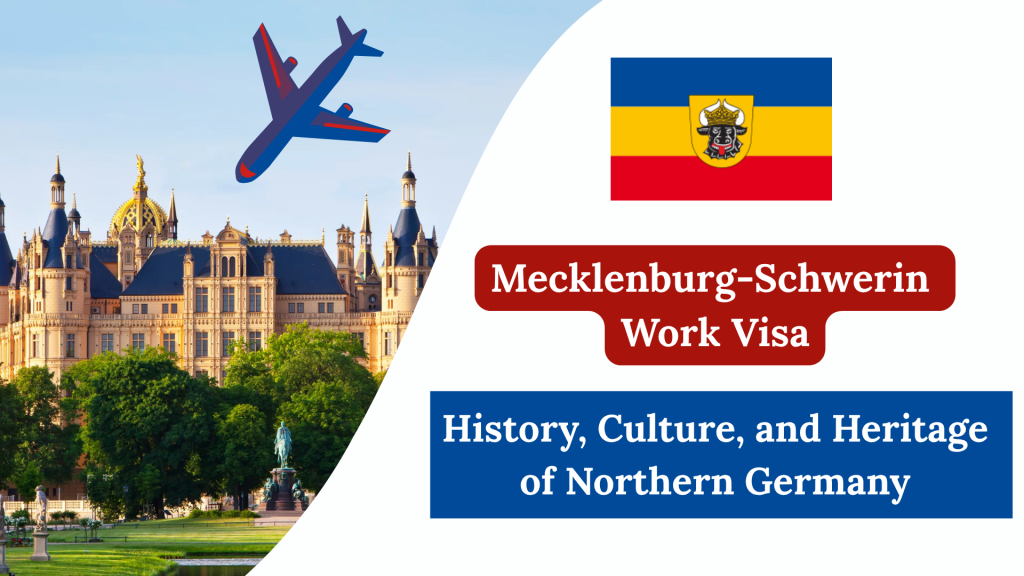Mecklenburg-Schwerin Work Visa. Mecklenburg-Schwerin was one of the historic states in northern Germany, known for its beautiful lakes, castles, and royal heritage. Once a grand duchy, it played a major role in shaping the region’s cultural and political identity. Today, Mecklenburg-Schwerin continues to attract visitors for its charming towns, stunning architecture, and peaceful landscapes.
What is Mecklenburg-Schwerin?
Mecklenburg-Schwerin was a grand duchy in northern Germany, existing between 1815 and 1918. It was one of the many small states that made up the German Confederation and later became part of the German Empire.
Its capital was Schwerin, a picturesque city famous for the magnificent Schwerin Castle, which stands on an island surrounded by a lake. The state was known for its rural beauty, agricultural economy, and noble traditions.
Early History of Mecklenburg-Schwerin
The origins of Mecklenburg-Schwerin go back to the Middle Ages, when the Slavic tribe known as the Obotrites settled in this region. During the 12th century, German settlers arrived, and the area was Christianized under Henry the Lion, Duke of Saxony.
Later, the House of Mecklenburg, one of the oldest noble families in Europe, ruled the region for centuries. In 1701, the territory of Mecklenburg was divided into two parts:
- Mecklenburg-Schwerin
- Mecklenburg-Strelitz
Both were governed separately but shared the same heritage and traditions.
Grand Duchy Era (1815–1918)
In 1815, after the Congress of Vienna, Mecklenburg-Schwerin was officially recognized as a Grand Duchy. It became part of the German Confederation, an alliance of German states formed after the fall of Napoleon.
During this time, the Grand Duchy was ruled by powerful dukes who modernized agriculture, supported education, and maintained peace in the region. The most famous among them was Grand Duke Friedrich Franz II, who ruled from 1842 to 1883. He was known for his interest in architecture and cultural development.
Under his leadership, Schwerin developed into a cultural and administrative center with beautiful buildings, gardens, and lakes.
Geography and Natural Beauty
Mecklenburg-Schwerin is located in northern Germany, bordered by the Baltic Sea to the north. The region is known for:
- Thousands of lakes, including Lake Schwerin and Lake Müritz
- Lush green forests and rolling hills
- Peaceful coastal towns and fishing villages
This natural beauty makes Mecklenburg-Schwerin one of the most scenic regions in Germany. Even today, tourists visit this area to experience the calm countryside and water landscapes that stretch for miles.
Economy and Agriculture
Historically, the economy of Mecklenburg-Schwerin was based on farming and agriculture. The fertile soil supported crops like wheat, barley, and potatoes. Livestock farming was also common, especially dairy and cattle production.
In the 19th century, small industries began to grow, including textiles, woodwork, and shipbuilding along the Baltic coast. Trade routes through the Elbe River connected the region to other parts of Germany and Europe.
Today, the region continues to value sustainable farming, tourism, and craftsmanship, keeping its rural traditions alive.
Royal Family and Culture
The House of Mecklenburg-Schwerin is one of the oldest noble families in Germany. It played a major role in European royal history through marriages and alliances with other royal families, including Russia and Denmark.
The people of Mecklenburg-Schwerin were known for their strong traditions, folk music, and festivals. The grand dukes encouraged art, literature, and education. The capital, Schwerin, became a cultural hub, filled with theaters, museums, and art galleries.
Even after the monarchy ended in 1918, the royal family’s legacy remains deeply respected. The Schwerin Castle, once their residence, is now a museum and government building — a living symbol of the duchy’s glorious past.
Schwerin Castle – The Jewel of the Region
The Schwerin Castle (Schweriner Schloss) is the most iconic landmark in Mecklenburg-Schwerin. Located on an island in Lake Schwerin, it is often called the “Neuschwanstein of the North” because of its fairytale design.
Key Features:
- Built in the 19th century on the site of an older fortress
- Combines Gothic Revival, Baroque, and Renaissance architectural styles
- Surrounded by gardens, bridges, and lakes, offering breathtaking views
Today, Schwerin Castle houses the State Parliament of Mecklenburg-Vorpommern and attracts thousands of visitors each year. It stands as a proud reminder of the region’s royal heritage.
End of The Monarchy and Modern Times
After World War I, the German monarchy was abolished, and Mecklenburg-Schwerin became a Free State within the Weimar Republic. Later, during World War II and the Cold War, the region became part of East Germany (GDR).
After Germany’s reunification in 1990, Mecklenburg-Schwerin became part of the modern federal state of Mecklenburg-Vorpommern. Schwerin continues to serve as the state capital, combining old-world charm with modern development.
Why Visit Mecklenburg-Schwerin?
Mecklenburg-Schwerin is a dream destination for travelers who love history, nature, and peace. Visitors can:
- Explore the Schwerin Castle and nearby museums
- Enjoy boat rides on the scenic lakes
- Visit historic churches, palaces, and gardens
- Experience German countryside life and local cuisine
The blend of culture, history, and natural landscapes makes Mecklenburg-Schwerin a unique region worth exploring.
Interesting Facts About Mecklenburg-Schwerin
| Fact | Description |
|---|---|
| Capital | Schwerin |
| Founded | 1701 (as part of Mecklenburg division) |
| Status | Grand Duchy (1815–1918) |
| Famous Landmark | Schwerin Castle |
| Modern State | Mecklenburg-Vorpommern |
| Known For | Lakes, castles, countryside, royal heritage |
FAQs About Mecklenburg-Schwerin
1. What was Mecklenburg-Schwerin known for?
It was known for its grand duchy status, royal family, beautiful lakes, and stunning architecture like Schwerin Castle.
2. Where is Mecklenburg-Schwerin located?
It is located in northern Germany, now part of the modern state called Mecklenburg-Vorpommern.
3. Who ruled Mecklenburg-Schwerin?
The region was ruled by the House of Mecklenburg, one of Europe’s oldest noble families.
4. What is the main attraction in Schwerin?
The Schwerin Castle, located on an island in Lake Schwerin, is the top attraction and a symbol of the duchy.
Conclusion
Mecklenburg-Schwerin is more than just a historic name — it represents a rich cultural and historical legacy that shaped northern Germany. From its royal past to its scenic lakes and castles, the region tells a story of beauty, resilience, and tradition.
Today, visitors can walk through its castles, relax by its lakes, and experience the timeless charm that once made it the heart of a German duchy.








